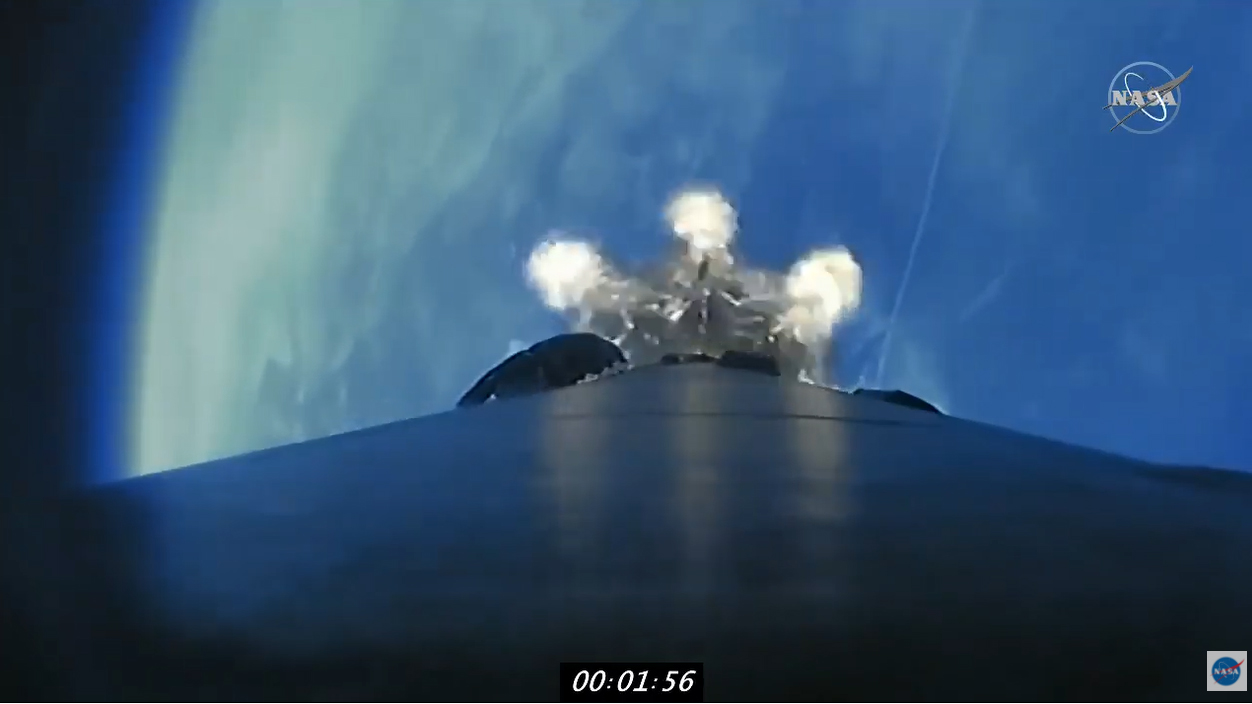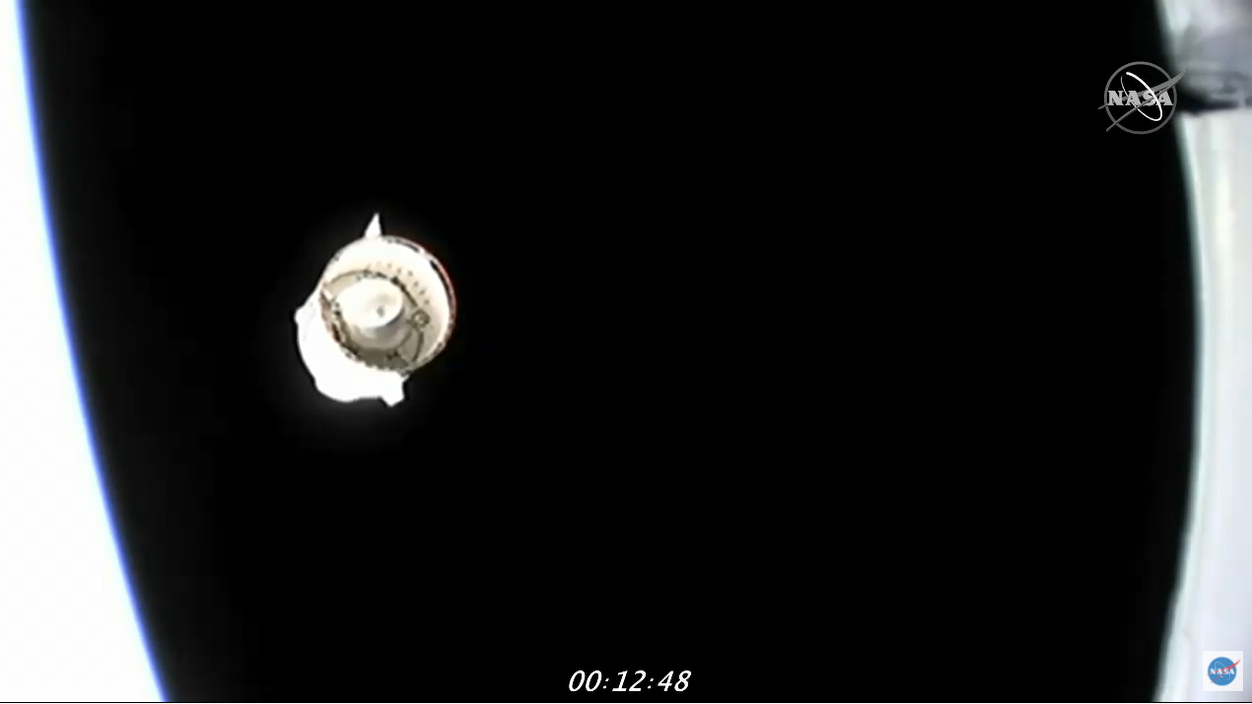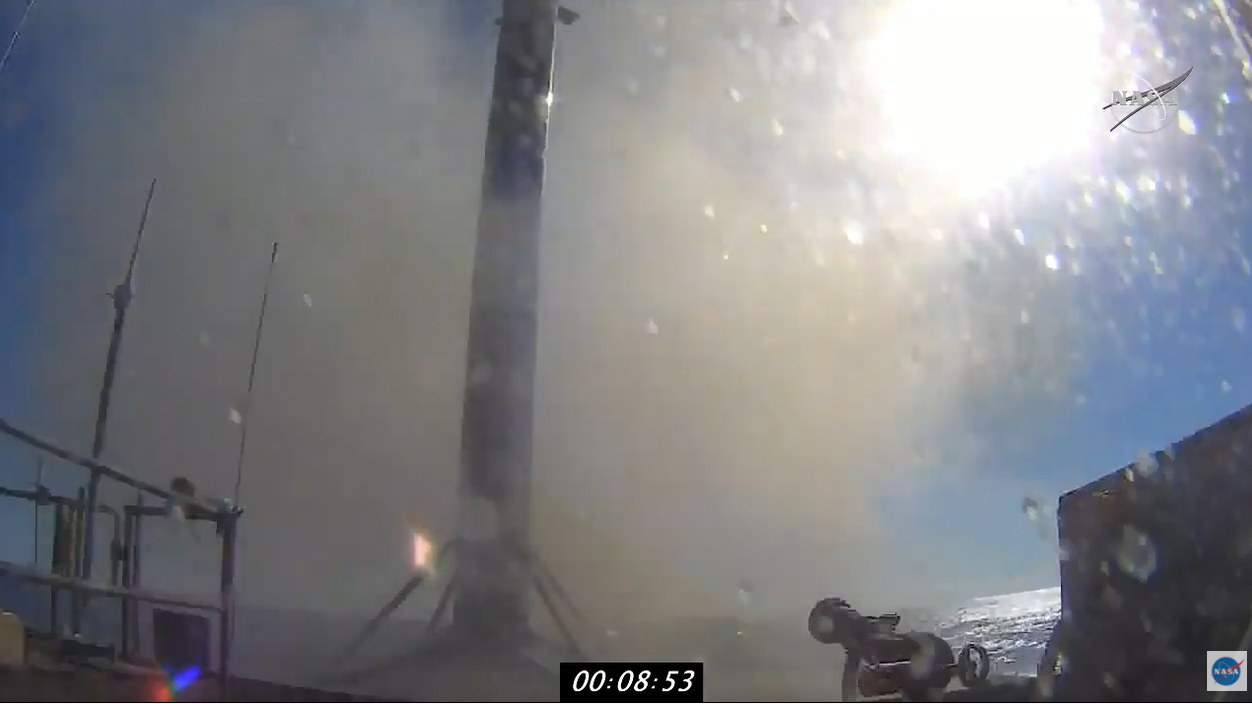SpaceX launches upgraded Dragon cargo ship to space station, aces rocket landing
CAPE CANAVERAL, Fla. — SpaceX successfully launched a new Dragon resupply mission today (Dec. 6), sending an upgraded cargo craft to the International Space Station for NASA.
A two-stage Falcon 9 rocket blasted off from Pad 39A today at NASA’s Kennedy Space Center at 11:17 a.m. EDT (1617 GMT), marking the company's 21st cargo mission for NASA and its 24th launch of the year. It was also a milestone 100th successful launch of a Falcon 9 over 101 missions for SpaceX.
Approximately 9 minutes later, the booster's first stage returned to Earth, landing on one of SpaceX's drone ships in the Atlantic Ocean in a smooth touchdown. The massive ship, called "Of Course I Still Love You," is one of two in the company’s fleet of recovery vessels that catch falling boosters and return them to port for later reuse.
Related: Tissue chips and organoids: The weird science on SpaceX's CRS-21
More: How SpaceX's Dragon Space Capsule Works (Infographic)



The weather outlook going into this weekend’s launch attempt was iffy, as weather officials with the 45th Space Wing predicted a 50% chance of favorable conditions at lift off on Saturday. Weather at the recovery zone proved to be too rough, so SpaceX decided to stand down from it’s planned launch attempt on Dec. 5. (If successful, it would have marked the third year in a row that the company launched a resupply mission on that day as CRS-16 launched in 2018, and CRS-19 in 2019.) However, Mother Nature did not cooperate.
But 24 hours later, on Sunday morning, the weather at both the launch site and the recovery zone were much better. The rocket was able to blast off and successfully deposit the Dragon cargo capsule into orbit.
It was nothing but blue skies here as the rocket leapt off the pad right on time. The rumble from the engines washed over onlookers as the rocket thundered towards orbit.
Breaking space news, the latest updates on rocket launches, skywatching events and more!
The first-stage booster featured in today's flight, known as B1058, has now launched and landed four times, marking the first booster that NASA has used with more than one flight under its belt. This frequent flier previously launched SpaceX's Demo-2 mission, which sent two NASA astronauts to the space station this past summer, well as a communications satellite for the South Korean military and a batch of the company’s own Starlink satellites.
The landing today marked the 68th recovery of a Falcon first stage since SpaceX recovered its first booster in 2015.
Christmas for the crew
The cargo craft is toting 6,400 lbs. (2,903 kilograms) of supplies and science investigations. The research gear will support a variety of experiments in the life sciences, regenerative medicine and many other fields. There may also be some Christmas treats tucked inside for the crew on orbit.
"The crew is going to get some type of Christmasy food on orbit," Kenny Todd, NASA’s Deputy program manager for the International Space Station (ISS) said during a prelaunch news conference on Dec. 4. "I don't think that will be any surprise to them, but anything more than that … I don't like to get out in front of Santa Claus."
“Let's see what happens when they open the hatch,” he added, noting he was optimistic that there may be more than just holiday food for the crew inside the Dragon.


For one astronaut on board, Christmas may come early in the form of a bevy of new research investigations that are tucked inside the Dragon. NASA astronaut Kate Rubins is not only a two-time space flier but also a world-class scientist. During her first space flight in 2016, she performed the first DNA sequencing on orbit.
"This particular dragon is going to bring about 4,400 lbs. (2,000 kg) of research with it. Which, if you know Kate Rubins, this is the ultimate Christmas present for Kate," Todd said. "I think the one challenge we're gonna have is probably trying to get her to let everybody else play with the new toys, when they get on orbit so we'll see, we'll see how that goes."
"She has been going like gangbusters for us," Kirt Costello, NASA's chief scientist for the International Space Station Program told Space.com.
"It's great to have [her] type of background, especially for these SpaceX missions where we focus on biological research," he said. "[Astronauts] are our eyes and ears on these investigations as they happen. It’s a great benefit to us, and they're also really excited about the science."
Related: SpaceX rocket launches for record 7th time, nails landing at sea
Dragons, Dragons, everywhere
Dragon will arrive at the station and dock at the Harmony module's space-facing port just over 24 hours after it launched. Once it reaches the space station, there will be two Dragon vehicles attached to the laboratory for the first time. The other is the Crew Dragon "Resilience," which launched on Nov. 15 carrying a crew of four astronauts.
"This is the first time we'll have a couple of Dragons onboard [the station] — we have the Crew Dragon and will soon have a Cargo Dragon," Todd said. "So, there will be Dragons everywhere you look. It'll be a lot of fun."
The upgraded version of cargo Dragon has advantages of its previous iteration. Designed to hold about 20% more cargo, it's bigger on the inside than its predecessor. According to Costello, the new iteration contains twice as many powered lockers as the earlier Dragon, which means more critical cargo and life science payload capability.
The craft can even store powered payloads while on orbit, and can stay on station twice as long as the previous cargo Dragons. Another key upgrade is that the cargo ships will now splash down in the Atlantic Ocean (versus the Pacific splashdowns of past flights), providing a faster return on science.
For researchers, that means they can get their samples and data back faster — in as little as 4 to 9 hours after splashdown — and for SpaceX that means that crews can get the vehicle back quicker and start performing inspections and maintenance before the Dragon’s next flight. Additionally, each new cargo Dragon spacecraft is certified to fly five times, versus the three times its predecessor could fly.
"I'm a big fan [of the faster return time]," Bill McLamb, chief scientist at Kentucky-based company Space Tango, told Space.com.
"For experiments, like those involving living systems, they recover from spaceflight effects pretty quickly upon return to Earth, so we want them back as soon as possible to process them right away," he said. "This helps facilitate that."
The upgraded Dragon 2 is going to enable us with some new capabilities for science but according to Costello, it’s also a way to really test NASA's commercial program and capabilities. "Having two Dragons on station is really going to test the program, to make sure we’ve really thought out all the processes."
Those processes will include how to park two Dragons on station as both versions of the spacecraft will now autonomously dock to the orbital outpost. (The previous cargo variant berthed to the space station with the help of the outpost's robotic arm.)
"It’s also a great opportunity to keep the science flowing and keep people engaged," Costello told Space.com. "Having these commercial programs has not only increased the amount of science we can do but also the number of crew members on station."
Typical crews of astronauts range from three to six, but with the Commercial Crew Program, NASA can now have a 4th crewmember on station, which doubles the amount of science the astronauts are able to do in a week.
"We've gone from doing 35 hours of science a week to 68," Costello said. "[Right now] having a fifth crew member on board is the cherry on top."
Falcon Ferry
This flight is the 101st overall flight of SpaceX's workhorse Falcon 9, including 100 successful missions and one launch failure in 2015. Thanks to a set of upgrades the launcher received in 2018, the California-based rocket manufacturer has really proven the worth of its fleet of veteran boosters.
Of SpaceX's 24 launches in 2020, the vast majority have lifted off on previously flown rockets. The booster used in this mission, known as B1058, first launched May 30 on another historic mission for NASA: the Demo-2 crewed flight, SpaceX's first astronaut mission, for NASA. It is emblazoned with the NASA's iconic worm logo.
Six months later, the same rocket carried a new Dragon spacecraft, this time full of cargo. When SpaceX was first selected to send crews and supplies for NASA, the agency required SpaceX to use brand new equipment for each launch, but as the company amped up its reusability efforts, NASA and even the military took notice. Both have since given the go ahead for SpaceX to use flight-proven hardware.
The next GPS III mission for the U.S. Space Force, set to launch next year, will be the first mission to fly on a used booster. While NASA has allowed SpaceX to fly its missions on refurbished hardware, this is the first time the agency has launched a mission on a rocket with more than one flight under its belt. A good sign for the company’s efforts.
2020 has been a banner year for SpaceX. It's record of 24 missions launched so far this year includes two different astronaut missions to the International Space Station in the past six months, the first-ever private crewed flights to the orbiting lab.
SpaceX isn't slowing down yet. The company has a few more missions up its sleeve this year, including the launch of a communications satellite for Sirius XM, which is expected to launch no earlier than Thursday, Dec. 10.
The company is also planning another hop test of its massive Mars rocket, called Starship. The latest prototype, known as SN8, is preparing to take flight in Texas this week. Earlier this year, the company proved that one of its next-generation Raptor engines could make a giant spray can fly, this latest version will more closely resemble the rocket that could carry future crews to Mars.
Powered by three Raptor engines, SN8 could leap in the air as high as 41,000 feet (12 m) as early as today (Dec. 6), just hours after it sent a Dragon to the space station.
Follow Amy Thompson on Twitter @astrogingersnap. Follow us on Twitter @Spacedotcom or Facebook.

Amy Thompson is a Florida-based space and science journalist, who joined Space.com as a contributing writer in 2015. She's passionate about all things space and is a huge science and science-fiction geek. Star Wars is her favorite fandom, with that sassy little droid, R2D2 being her favorite. She studied science at the University of Florida, earning a degree in microbiology. Her work has also been published in Newsweek, VICE, Smithsonian, and many more. Now she chases rockets, writing about launches, commercial space, space station science, and everything in between.

